|
|
|
Sort Order |
|
|
|
Items / Page
|
|
|
|
|
|
|
| Srl | Item |
| 1 |
ID:
133289
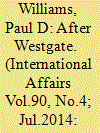

|
|
|
|
|
| Publication |
2014.
|
| Summary/Abstract |
The attack on the Westgate Mall in Nairobi, Kenya, in September 2013 intensified international scrutiny of the war against Harakat Al-Shabaab Mujahideen (Movement of the Warrior Youth). This article analyses the current state of affairs with reference to the three principal sets of actors in this war: Al-Shabaab, the African Union Mission in Somalia (AMISOM) and its international partners, and the various actors currently involved in building the Somali Federal Government's security forces. It argues that although the newly reconfigured Al-Shabaab poses a major tactical threat in Somalia and across the wider Horn of Africa, the movement is becoming a less important actor in Somalia's national politics. As Al-Shabaab loses territory and its popularity among Somalis continues to dwindle, other clan- and region-based actors will become more salient as national debates over federalism, the decentralization of governance mechanisms beyond Mogadishu and the place of clannism will occupy centre stage. As a consequence, AMISOM's principal roles should gradually shift from degrading Al-Shabaab towards a broader stabilization agenda: encouraging a national consensus over how to build effective governance structures; developing an effective set of Somali National Security Forces; and ensuring that the Federal Government delivers services and effective governance to its citizens, especially beyond Mogadishu in the settlements recently captured from Al-Shabaab. As it stands, however, AMISOM is not prepared to carry out these activities. More worryingly, nor is the Somali Federal Government.
|
|
|
|
|
|
|
|
|
|
|
|
|
|
|
|
| 2 |
ID:
141963
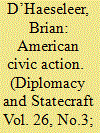

|
|
|
|
|
| Summary/Abstract |
From 1979 until 1992, the United States government intervened in the Salvadoran Civil War to defeat ‘communist revolution,’ establish a moderate, centrist government, and prevent its overthrow. One of the primary means to accomplish American goals in El Salvador rested on a thorough application of counter-insurgency. In particular, American and Salvadoran strategists used civic action programmes to win the ‘hearts and minds’ of Salvadorans and gain their allegiance. In 1983, whilst the war was at its zenith, the Salvadoran military launched an important counter-insurgency effort that attempted to reverse the government’s fortunes. Unfortunately, these plans failed to affect decisively the outcome of the conflict. Regardless, given their failure in the largest American intervention in the post-Vietnam era, they continue to remain a fundamental aspect of American counter-insurgency doctrine.
|
|
|
|
|
|
|
|
|
|
|
|
|
|
|
|
| 3 |
ID:
133849
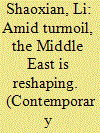

|
|
|
|
|
| Publication |
2014.
|
| Summary/Abstract |
Turmoil in Iraq reached a new level when ISIL seized Mosul after the Iraq security force collapsed on June 10. Although ISIL, the Islamic State in Iraq and the Levant , look after over Fallujah in early 2014, this latest development has deeper repercussions. On June 29, ISIL declared a large territory between Iraq and Syria a new state.
|
|
|
|
|
|
|
|
|
|
|
|
|
|
|
|
| 4 |
ID:
091487


|
|
|
|
|
| Publication |
2009.
|
| Summary/Abstract |
This article examines the ways and means in which states employ irregular and indigenous personnel in a counter-insurgency (COIN) or counter-terrorist (CT) campaign, in the historical and contemporary context. The authors clarify the terminology surrounding this neglected area of COIN/CT theory, and identify four types of indigenous assistance - individual actors (trackers, interpreters, informers and agents); home guards and militias; counter-gangs; and pseudo-gangs. This article concludes that while the use of such indigenous irregulars has its advantages for the state and its armed/security forces (particularly as far as intelligence, local knowledge and undermining the insurgent's cause is concerned), it can also have serious practical and ethical implications for a COIN/CT campaign, and can have unexpected and unwelcome consequences including violations of laws of armed conflict, the undermining of governmental authority and the prospects of endemic internal strife and state collapse.
|
|
|
|
|
|
|
|
|
|
|
|
|
|
|
|
| 5 |
ID:
152024
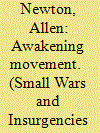

|
|
|
|
|
| Summary/Abstract |
This essay analyzes the link between mobilization and tribalism that developed in the Anbar Awakening. The Anbar Awakening exposed the Anbari tribal structure as a deeply entrenched and complex network deployed to mobilize support and generate behavior that would achieve the most advantageous strategy and position in a fight against al-Qaeda. Although this description supports David Kilcullen’s tribal society model, the rules of the Awakening movement that restored the tribal network were hardly explored by counter-insurgents for value and opportunity. The essay therefore draws on narratives from Anbari sheikhs to analyze the properties of tribalism (culture, identity, and problem-solving) as a non-linear social network, and demonstrates a paradigm in which mobilization of Anbari tribesmen is a valid indicator of security. The link between mobilization and tribalism in the Anbar Awakening therefore strategically develops to intervene in social life and address security locally.
|
|
|
|
|
|
|
|
|
|
|
|
|
|
|
|
| 6 |
ID:
133352
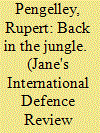

|
|
|
|
|
| Publication |
2014.
|
| Summary/Abstract |
Ground troops have been spoiled for communications choices in Afghanistan and elsewhere, but communication in the jungle remain as much an art as they are a science and need regular practice. Rupert Pengelley investigates.
|
|
|
|
|
|
|
|
|
|
|
|
|
|
|
|
| 7 |
ID:
137161
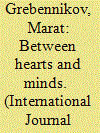

|
|
|
|
|
| Summary/Abstract |
Although Russian authorities point to the supposed success of Britain’s late colonial counter-insurgency campaigns as a model even in the 21st century, their grasp of the historical lessons is partial at best. This article considers the applicability and relevance of the counter-insurgency experience of the late British colonial state to present-day ethno-religious conflicts in the North Caucasus. The article suggests that the flexibility of British arrangements for counter-insurgency was a major factor in achieving long-term stability for the gradual transition to indigenous self-rule. The key practice was to devolve responsibility and power to indigenous elites operating with a high degree of autonomy. The article then proposes guidelines relevant to the conditions of the present and the near future that will affect prospects both for full-fledged democratization of Russia and for effective state-building, also vitally important for the development of the North Caucasus. The article concludes that the most relevant factor in the British counter-insurgency experience is to win the hearts and minds of the population. However, this cannot be achieved without a legitimate indigenous administration capable of taking full responsibility and ownership of the campaign. Otherwise, diminished political access and accountability create propitious conditions for adherents of radical movements, who are increasingly capable of and prepared to use violence and who are the only de facto rival political forces within the Russian Federation.
|
|
|
|
|
|
|
|
|
|
|
|
|
|
|
|
| 8 |
ID:
164148
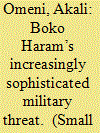

|
|
|
|
|
| Summary/Abstract |
This paper evaluates Boko Haram’s military capabilities and details the process of how its standing army, driven by these capabilities, came to pose a phased threat between 2013 and 2015 in particular. This was a period when military fighting dominated the insurgency in north-east Nigeria. Whereas there is an abundance of literature on Boko Haram’s histories and the impact of its insurgency on north-east Nigeria, analysis of Boko Haram’s military campaigning is still deficient. Attempting to fill this gap, this paper uses field findings and battlefield case studies from north-east Nigeria to highlight how Boko Haram’s overt front – its standing army – came to supplant its guerrilla operations as the main security threat to the frontier area.
|
|
|
|
|
|
|
|
|
|
|
|
|
|
|
|
| 9 |
ID:
181041


|
|
|
|
|
| Summary/Abstract |
Throughout the 1950s Britain faced unprecedented challenges to its imperial rule. Civil disobedience, insurgency and terrorism gripped its colonies as the flames of nationalism and anti-colonialism burned brightly across the world. In two of Britain’s most important Cold War strategic outposts, Northern Ireland and Cyprus, insurgents belonging to the IRA and EOKA launched armed campaigns to undermine British rule. This article examines the insurgencies on both islands in the period 1955–59, comparing the respective approaches taken by the IRA and EOKA to guerrilla warfare. Drawing on original English and Greek language sources, as well as other empirical evidence, the article argues that the IRA and EOKA interpreted their struggles in complementary ways as part of a broader national liberation struggle, which, above all, suggests a shared understanding of British imperialism. Admittedly, beyond a mutually perceived ‘brotherly bond’, IRA leaders did not apply specific military lessons they had learned from members of EOKA while in English prisons in the 1950s until the much later Northern Ireland ‘Troubles’. Nevertheless, we argue that it is important to look at the genealogy of ideas for it reveals broader patterns regarding the organisational learning of militant groups engaged in campaigns against a common enemy.
|
|
|
|
|
|
|
|
|
|
|
|
|
|
|
|
| 10 |
ID:
168215
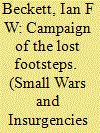

|
|
|
|
|
| Summary/Abstract |
What Rudyard Kipling called the ‘campaign of lost footsteps’ was the longest campaign fought by the Victorian army. The conquest of Upper Burma, an area of 140,000 sq. miles with a population of four million, took only three weeks in November 1885 and was accomplished with minimum cost. However, the removal and deportation of the Burmese King and dismantling of all traditional authority dismantled led to growing resistance to British rule leading to an increasingly difficult guerrilla war. Though the Burmese guerrillas were characterised by the British as mere bandits or dacoits, many were former soldiers along with Buddhist monks. The extremely difficult nature of campaigning in the terrain and climate of Burma was not sufficiently appreciated by the War Office, who viewed the conflict as a ‘subaltern’s war’ and ‘police’ work. Intended regime change was also not accompanied by any consideration of the likely implications. Prolonged insurgency necessitated deploying a force far larger than originally intended; though order was finally secured by 1895, the campaign proved destructive of Burmese society while British recruitment of hill tribes into the police and armed forces sowed the seeds for future divisions.
|
|
|
|
|
|
|
|
|
|
|
|
|
|
|
|
| 11 |
ID:
197671


|
|
|
|
|
| Summary/Abstract |
The security situation in the Sahel region has been deteriorating with a consistent increase in violence. Despite tens of thousands of international troops in the region for over a decade, little headway has been made in establishing government control over the territory. The ongoing multilateral and large-scale military operations in the region have employed a boots-on-the-ground strategy that has been largely ineffective in stamping out the insurgency. The paper advocates for a recalibrated counter-insurgency strategy predicated on drones’ heightened and consistent deployment for counter-insurgency operations in the West African Sahel. This is in response to France's phased withdrawal from the region and the limited effectiveness of current multilateral military endeavours to quell the insurgency. The paper presents two related arguments hinged on the tactical utility of drones, drawing on the concept of ungoverned spaces as a theoretical foundation.
|
|
|
|
|
|
|
|
|
|
|
|
|
|
|
|
| 12 |
ID:
105247
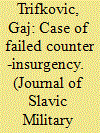

|
|
|
|
|
| Publication |
2011.
|
| Summary/Abstract |
This article examines operations "Weiss" and "Schwarz," two of the largest anti-guerrilla sweeps conducted by the German Wehrmacht during the entire Second World War. Four reinforced divisions with ca. 65,000 German soldiers and up to 100 aircraft took part in what is regarded as the most ferocious fighting of the whole war in Yugoslavia. Although conducted with maximum effort in material terms, they were doomed to failure because of the Third Reich's neglect of guerrilla warfare and the resulting lack of a sound counter-insurgency doctrine. Remarkably, operations "Weiss" and "Schwarz" are almost unknown to the public in the West, despite their sheer size. As the founding myths of socialist Yugoslavia, they were extensively written about, almost always from a Partisan perspective. This is the first article to describe the events from the German point of view, and to analyze the Wehrmacht's conduct of these operations in some depth. With the ongoing COIN campaigns in Iraq and Afghanistan, examining the lessons from the past can prove enlightening.
|
|
|
|
|
|
|
|
|
|
|
|
|
|
|
|
| 13 |
ID:
102960
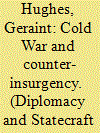

|
|
|
|
|
| Publication |
2011.
|
| Summary/Abstract |
Due to the American-led interventions in Afghanistan and Iraq, theories surrounding counter-insurgency, or COIN, have aroused intense debate in political, military, and academic circles in the United States, Britain, and other Western countries. This article shows that current thinking about how to fight and defeat insurgent movements is based primarily on Cold War-era theories and conflicts. It traces the evolution in COIN thinking both before and during the Cold War-incorporating Western and Eastern bloc experiences of war against insurgents from Malaya to Afghanistan-but also illustrates the conceptual difficulties of applying doctrines based on the historical record of this era. The article concludes by arguing that theories derived from the experiences of states involved in COIN campaigns from 1945 to 1991 still retain utility, but that there are significant differences between Cold War insurgencies and current conflicts associated with the "war on terror"/"long war" which affect the applicability of doctrines based on historical analysis and the works of Thompson, Kitson, Galula, and other "classic" theorists.
|
|
|
|
|
|
|
|
|
|
|
|
|
|
|
|
| 14 |
ID:
185568
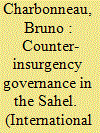

|
|
|
|
|
| Summary/Abstract |
Since 2013, the multiplication of regional and international strategies and actions directed at stabilizing Mali and the Sahel, and at countering and preventing violent extremism, has not improved the situation there and, arguably, some of it has made it worse. This article analyses the type of political order and regional governance that has been and is being built after almost a decade of international interventions in the West African Sahel. It is an effort at theorizing and making sense of what is considered here to be a permanent state of intervention in the Sahel that has evolved into a form of counterinsurgency governance—a concept being proposed to point to the influence and the infusion of counterinsurgency principles into philosophies of governance. This article argues that counterinsurgency governance insists on a set of power relations and configurations that seeks to impose limits, parameters and boundaries to the purpose of and the form that Sahelian states, governments and governance ought to take. As such, counterinsurgency governance is simultaneously a mode of governance and a web of political practices and contestation whose mechanisms have failed at fully implementing its principles in the Sahel. Its fallback is the emergence of a regional strategy to manage and establish limits to Sahelian political possibilities.
|
|
|
|
|
|
|
|
|
|
|
|
|
|
|
|
| 15 |
ID:
158712
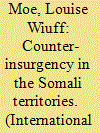

|
|
|
|
|
| Summary/Abstract |
This article explores how contemporary counter-insurgency and peacebuilding converge around a pragmatic interventionary discourse that reinvents historical pacification practices centred on bottom-up support for local coercion wielders and securitized institution-building. The analysis combines a historical perspective on the changing position and meaning of peace in relation to counter-insurgency with an exploration of contemporary articulations of war with peace in interventions in the Somali context. Through analyses of the cases of Jubaland and Somaliland—two sites where counter-insurgency has adapted to the limitations of state-centric stabilization by instead targeting institutions and actors beyond the host nation government—the article explores how contemporary counter-insurgency embeds itself within the legitimating vocabulary of peace and bottom up reconstruction, and draws on the operational tools provided by peacebuilders. Moreover, it demonstrates how these tools are thereby reframed in such a way that their stated peacefulness is subjugated to counter-insurgency campaign objectives—with far from peaceful effects on local orders. By teasing out these effects through empirical examples, and by offering a historical contextualization of the examples, the article reappraises understandings of contemporary counter-insurgency as a benevolent and locally-sensitive approach to defeating ‘subversion’ and installing peace—instead it conveys the marked resemblance to colonial and Cold War efforts of pacification. This highlights the importance of closely examining the specific geopolitical and policy contexts in which the terms of the debate on bottom-up peace circulate, as well as the different intervention agendas with which such proposals become entwined.
|
|
|
|
|
|
|
|
|
|
|
|
|
|
|
|
| 16 |
ID:
177675
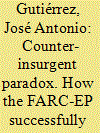

|
|
|
|
|
| Summary/Abstract |
Institutions are historical products shaped by power and contestation which don’t necessarily respond to the purpose for which they were originally created. I will explore how ‘communal action’ institutions created to contain the advancement of the insurgent movement in rural Colombia in the 1950s were eventually used by guerrillas, notably the FARC-EP. Through them, rebels advanced their political agenda, reinforcing their organisational work in rural communities. The strategic impact of this contradictory process, cannot be over-stated, for it turned the struggle of rebels against the State into a struggle fought squarely within the very structures of the State they antagonised.
|
|
|
|
|
|
|
|
|
|
|
|
|
|
|
|
| 17 |
ID:
089841
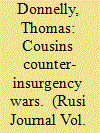

|
|
|
|
|
| Publication |
2009.
|
| Summary/Abstract |
By 2008, in the face of mounting criticism of the British performance in Iraq and clear evidence that the US surge was 'working', the transatlantic debate on small wars had been inverted: 'Basra' had supplanted 'Malaya' as shorthand for British skill in irregular warfare; it was now the Americans who seemed the masters of modern counter-insurgency and the British the students in need of instruction. The author examines what this apparent role reversal - and the accompanying 'family feud' - really says about Anglophone armies.
|
|
|
|
|
|
|
|
|
|
|
|
|
|
|
|
| 18 |
ID:
133068
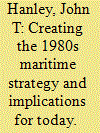

|
|
|
|
|
| Publication |
2014.
|
| Summary/Abstract |
While important differences exist, the first decade of the twenty-first century paralleled the 1970s for the Department of Defense and the U.S. Navy. U.S. armed forces were embroiled in extended and expensive counterinsurgency wars. American military equipment was growing old, budgets were tight, and extended projections called for significant decreases in the nation's armed forces, just as the main prospective military adversary was both rapidly modernizing and expanding its forces, particularly its navy. "From 1962 to 1972, the navy had programmed the construction of 42 ships per year, but between 1968 and 1975 only 12 ships, or less than a third as many per year, were programmed. In 1975, given the age of ships already at sea, and the navy-expected service life for a warship of 25-30 years, the service anticipated retiring about 4 percent of the active fleet each year."1 The Soviets were extending their defensive perimeter from two to three thousand kilometers.2 Today, the Chinese suggest extending their defensive perimeter from the "first island chain," enclosing the East and South China Seas, to the second, bounded by the Marianas, three thousand kilometers from the Chinese coast.3 In the 1970s, the United States questioned its own ability to fight forward, defend allies, and achieve objectives -as many defense analysts and many in the Navy do now.
|
|
|
|
|
|
|
|
|
|
|
|
|
|
|
|
| 19 |
ID:
124744
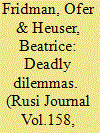

|
|
|
|
|
| Publication |
2013.
|
| Summary/Abstract |
Since the second world war, counter insurgency and counter terrorism operations have become much more frequent and widespread than large scale conventional confrontation. While at first three was a widespread perception that relatively small badly trained and poorly equipped groups.
|
|
|
|
|
|
|
|
|
|
|
|
|
|
|
|
| 20 |
ID:
133684
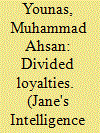

|
|
|
|
|
| Publication |
2014.
|
| Summary/Abstract |
The top leadership of the Jihadist militant organization Tehrik-e-Taliban Pakistan has fractured after months of infighting. Muhammad Ahsan Younas reviews the events that caused the group to fracture ant the implications for its future operations.
|
|
|
|
|
|
|
|
|
|
|
|
|
|
|
|
|
|
|
|
|